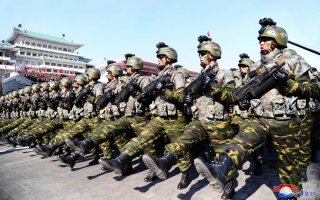North Korea Might Have Lots of Guns, But Are They Any Good?
Pyongyang's military is still not very modernized.
Here's What You Need to Know: The strength of North Korea's infantry remains questionable.
Infantry weapons have long been a pillar of the North Korean People’s Army, or KPA for short. The KPA that invaded South Korea was largely an infantry army, and despite significant mechanization in the 1970s the foundation of the army has been its infantry forces. Today, the bulk of the KPA’s 1.1 million army is infantry, with approximately 200,000 light infantry and special forces.
After the Korean War, North Korea followed the Soviet Union’s lead in infantry weapons. The oldest gun still in service is the KPA Type 58 assault rifle. A clone of the Soviet AK-47, the Type 58 was produced in two factories, #61 and #65 located near Chongjin, between 1958 and 1968. The Type 58 was a basic AK-pattern rifle with a 30 round magazine and a rate of fire of up to 650 rounds per minute. Approximately 800,000 rifles were produced, and while the 7.62-millimeter assault rifle is no longer in service with frontline units it allegedly still equips reserve units and militia.
A new rifle, the Type 68, was a clone of the Soviet AKM assault rifle and manufactured beginning in 1968. In practical terms the Type 68 had few major improvements over the Type 58, although it did come with a folding stock. The Type 68 was also extensively exported abroad, to El Salvadoran Marxist guerrillas and across Central and South America. These rifles are also likely still in service with reservists and rear-area units, as North Korea is undoubtedly still sitting on a considerable supply of 7.62 rifle ammunition.
The KPAGF’s main weapon is the Type 88 assault rifle. The weapon is similar to the Soviet AK-74, although at least one report suggests it may be derived more from the Chinese copy of the AK-74 than the original Soviet weapon. The weapon represents a major logistical break for the KPAGF, using 5.45-millimeter ammunition instead of the the 7.62 round utilized by previous rifles. The Type 88 may have started out in special commando units but appears to have gradually spread out into regular army units. North Korean watchers have spotted the Type 88 using helical magazines capable of carrying more than one hundred rounds of ammunition and the rifle also formed the basis for North Korea’s version of the U.S. Army’s Objective Individual Combat Weapon, a combination gun/grenade launcher weapon equipped with an advanced gunsight.
North Korea also maintains a small arsenal of M-16 pattern rifles. Several such rifles were reportedly found on the bodies of infiltrators during the 1996 Gangneung incident. The South Korean military at one time used M-16A1 rifles and the weapon could have been used by agents and saboteurs to impersonate South Korean military personnel. It’s not clear where these weapons came from: one report suggests the rifles could have been Chinese Norinco CQ rifles, but North Korea’s history suggests that the weapons could have come from Central or South American guerrillas or even Vietnam.
North Korea’s early squad automatic weapon, the Type 73, was an idiosyncratic weapon: based on the Soviet PKM machine gun, it featured a dual-feed ammunition system allowing it to accept metal belted ammunition but also vertically loaded 30 round magazines similar to the Czechoslovakian Vz. 52 or British Army Bren machine gun. The dual feed system has always been something of a mystery, as the Type 73 uses different ammunition than North Korean assault rifles and as such there is no commonality. Vertical magazines do however allow machine gunners to fire from the prone position and while belted ammo can do the same thing feeding belts can allow the machine gun to ingest debris and jam. Even more intriguingly, the Type 73 can fire rifle grenades.
North Korea’s follow-on machine gun and their current squad-level support firearm, the Type 82, was introduced in 1982 and is a more orthodox weapon. The Type 82 bears greater similarity to the PK-PKM machine guns, lacks a magazine fed option, and is belt-fed only.
North Korea’s light infantry and special forces are taking on increasing importance as the country’s aging mechanized units, starved for technology and fuel, are likely becoming less relevant to the country’s war plans. The guns of the KPA Ground Forces help ensure North Korean sniper, airborne, and marine infantry units remain operationally relevant now and into the near future. Whether this impoverished country with an economy smaller than Panama’s can arm their infantrymen as well as their American and South Korean counterparts, while simultaneously affording an expanding nuclear arsenal is another question.
Kyle Mizokami is a defense and national-security writer based in San Francisco who has appeared in the Diplomat, Foreign Policy, War is Boring and the Daily Beast. In 2009, he cofounded the defense and security blog Japan Security Watch. You can follow him on Twitter: @KyleMizokami.
This article first appeared several years ago.
Image: Reuters

